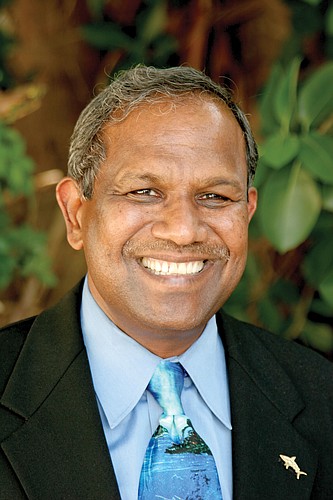- April 17, 2024
-
-
Loading

Loading

We live in an area easily described as paradise. The sun, the beaches, the weather; for the most part, we have it all.
Our only challenges are the occasional threats from natural events such as hurricanes or red tide — like the bloom that has now been identified off of southern Sarasota County and south to Charlotte and Lee counties.
Red tides occur throughout the world, caused by many different species of algae. Here in Florida, red tides are a natural phenomenon caused by a particular species called Karenia brevis, which is found almost exclusively in the Gulf of Mexico. K. brevis always occurs naturally in our waters, but it becomes noticeable by us when it occurs in higher-than-normal concentrations — when it “blooms” to millions of cells per liter of sea water.
We notice it because this species of algae produces potent neurotoxins that can kill fish and other marine life. It can also impact the health of humans who breathe in airborne toxins or who ingest them by eating shellfish from unregulated sources.
Red tides can also bring adverse economic impacts in the order of several million dollars from reduced visitor numbers and the subsequent affect on the tourism industry, as well as increased beach-cleanup costs incurred by local governments.
Mote scientists are world leaders in the study of Florida red tide and its impacts and have continuously been involved in this area of research for more than 40 years. During that time, we have made major breakthroughs in red-tide prediction and monitoring and in understanding how red tide affects the health of humans — especially people with chronic lung diseases.
Our scientists were the first to identify airborne toxins in the field. We also developed and patented a special machine called a BreveBuster that can automatically detect the presence of K. brevis in the water column. The BreveBusters are mounted on Automated Underwater Vehicles (AUV) that can patrol our waters and transmit data on the presence of red tide. Our scientists also helped lead the only long-term study of the effects of Florida’s red tide on human health, a project funded by the National Institute of Environmental and Health Sciences, that led to the finding and new public health message that people with chronic lung diseases should avoid areas being affected by red tide.
Our past studies have tested the effectiveness of using clay and ozone in controlling and mitigating red tide blooms — both generally found to be ineffective for our circumstances. But some of our newest studies are focused on finding innovative natural methods that could one day be used to control a bloom or lessen its severity. For instance, we’re looking at the feasibility of using other competing and naturally occurring algae or parasites of K. brevis to control red tide blooms.
Many of these efforts have taken place in partnership with Florida’s Fish and Wildlife Conservation Commission (FWC), the National Oceanic and Atmospheric Administration (NOAA), the University of South Florida (USF) and the grassroots organization, Solutions to Avoid Red Tide (START). Studies are funded with a combination of governmental funds, federal and state, and generous contributions from foundations and local donors.
Because red tide blooms start offshore, detection and tracking are the keys in our ability to mitigate the effects of a bloom. Our scientists, in partnership with many other agencies, including FWC and the Sarasota County continuously monitor area waters for red tide. Thanks to this water-sampling program, we knew that a bloom was developing offshore and that we needed to implement our event response plan.
Close collaboration with FWC, NOAA, USF and even NASA is at the heart of this response plan. We are all working together to understand how large the bloom is, where it is going, how severe it is and what the impacts will be on our coastal communities. Each agency or organization has its own specialty, and by working together we are better able to muster limited resources to greater effect.
We’ve also been working to keep our coastal residents and visitors informed about the actual conditions. In addition to the research we do, Mote scientists inform public outreach and educational programming that showcases their studies at The Aquarium, and teaches k-12 students, as well as adults, through informal age-specific programs and events. As a public service, Mote also presents information about red tide to local, regional, national and international community groups. Scientists also provide testimony and briefings to elected officials and government representatives.
So far, we have been fortunate in that the wind conditions have kept the bloom mostly offshore. But, as all Floridians know, wind and weather patterns can quickly change.
That’s why Mote also developed the Beach Conditions Reporting System. Through this system, trained beach observers report current conditions on 25 Gulf Coast Florida beaches at 10 a.m. and 3 p.m. daily. They report on a number of factors, including whether beachgoers are experiencing respiratory irritation or whether dead fish are present on the beach. The public can see these reports online at mote.org/beaches or receive updates by phone by calling 941-BEACHES. We’re also working with FWC to implement a new red tide Facebook page.
We don’t know how long this bloom will last or how much it will impact our communities, but we hope that these information resources and updates about the scientific progress we are all making will help mitigate its effects on us all.
Dr. Kumar Mahadevan has been at Mote Marine Laboratory for more than 34 years and is the organization’s president and CEO.